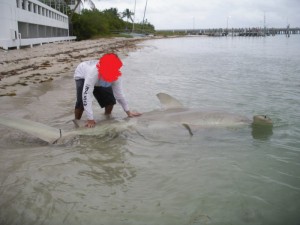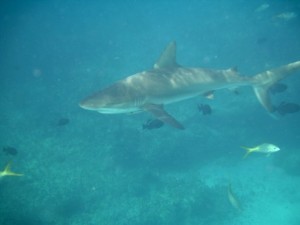
Update: The angler who originally caught the shark has responded. Please see below.

On February 5th, while standing on a beach in Miami, a fisherman caught a 14 foot great hammerhead shark. According to his account, “we had it beached within an hour of hooking it. The fish weighed too much her girth was huge. Just the 2 of us wasn’t enough to get it out of the water….We snapped some pictures with our dying camera, measured it at 170 inches and spent the next hour walking back and forth with HER reviving her…it swam off slow and steady”
While this might appear to be a simple case of catch-and-release recreational fishing, it is not. My lab and I are supporters of sustainable catch and release fishing. However, it is important to note that since January 1, 2012, great hammerheads (an IUCN Red List Endangered species) have been a protected species in Florida state waters and have additional legal protections. The Florida code indicates that:
“(1) No person shall harvest, possess, land, purchase, sell, or exchange any or any part of these species:
…(k) Great hammerhead – Sphyrna mokarran.…(3) “Harvest” means the catching or taking of a marine organism by any means whatsoever, followed by a reduction of such organism to possession. Marine organisms that are caught but immediately returned to the water free, alive, and unharmed are not harvested”
…(5) “Land,” when used in connection with the harvest of marine organisms, means the physical act of bringing the harvested organism ashore” Florida code section 68B-44 (Emphasis mine)
In this incident, the shark was brought ashore. We can infer from the statement “the fish weighed too much her girth was huge. Just the 2 of us wasn’t enough to get it out of the water” that the fisherman attempted to pull it all the way out of the water, but was unable to do so (an important legal distinction) . Instead, he ended up beaching it, bringing it so far out that it could not move or breathe. The angler did not immediately release the animal. According to the angler’s account, it was measured and photographed prior to the attempt to resuscitate it. The shark was not released alive and unharmed. By the angler’s own admission, it took over an hour of resuscitation before the animal was able to even swim away slowly.
Read More “Florida angler catches (and likely kills) Endangered great hammerhead shark” »
